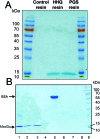A new Pseudomonas quinolone signal (PQS) binding partner: MexG
- PMID: 28660026
- PMCID: PMC5477026
- DOI: 10.1039/c5sc04197j
A new Pseudomonas quinolone signal (PQS) binding partner: MexG
Abstract
The opportunistic pathogen Pseudomonas aeruginosa utilises the cell-cell signalling mechanism known as quorum sensing to regulate virulence. P. aeruginosa produces two quinolone-based quorum sensing signalling molecules; the Pseudomonas quinolone signal (PQS) and its biosynthetic precursor 2-heptyl-4(1H)-quinolone (HHQ). To date, only one receptor (the PqsR protein) has been identified that is capable of binding PQS and HHQ. Here, we report on the synthesis of PQS and HHQ affinity probes for chemical proteomic studies. The PQS affinity probe very effectively captured PqsR in vitro. In addition, we also identified an interaction between PQS and the "orphan" RND efflux pump protein, MexG. The PQS-MexG interaction was further confirmed by purifying MexG and characterizing its ability to bind PQS and HHQ in vitro. Our findings suggest that PQS may have multiple binding partners in the cell and provide important new tools for studying quinolone signalling in P. aeruginosa and other organisms.
Figures







References
Grants and funding
LinkOut - more resources
Full Text Sources
Other Literature Sources

